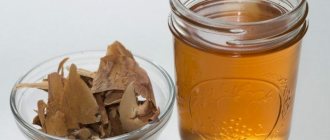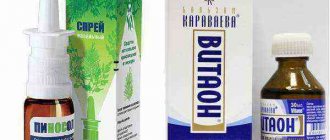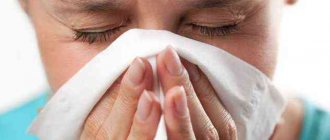About 10% of patients suffer from chronic diseases of the upper respiratory tract. This condition is almost always accompanied by swelling of the nasal mucosa, which is called subatrophic rhinitis, and also occurs in a chronic form. The patient's quality of life deteriorates significantly, as does his ability to breathe normally. Dryness and itching occur in the nose, which are accompanied by the appearance of crusts with a foul odor. What are the true causes of this disease and how to fight it?
Clinical picture
At the onset of the disease, there is insufficient moisture in the nasal mucosa, which causes it to dry out and peel.
Nasal breathing becomes difficult, unpleasant sensations appear in the nose, including burning.
In the absence of moisture, epithelial cells quickly die and accumulate in the nasal passages in the form of crusts.
If you do not start treatment at this stage, bleeding will be added to the discomfort in the nose, the sense of smell will be significantly dulled, and then taste. This is how subatrophic rhinitis develops.
In the international classification of diseases according to IBC-10, it is assigned code J31.0. The difference between this type of disease is that it is not characterized by copious mucus secretion from the nasal passages, which cannot be said about other types of runny nose, which are usually accompanied by an abundance of snot.
Features of the occurrence and development of rhinitis:
How to treat chronic atrophic rhinitis?
Chronic atrophic rhinitis is a pathology of the mucous membrane of the nasal cavity, in which there is a violation of the structure, atrophy and degradation of the tissue, and therefore the organ cannot fully perform its own function. In very severe stages of the disease, the inflammatory process spreads to the bone tissue, which leads to its partial or complete destruction. It occurs and occurs in children and adults without visible differences.
ICD 10 code
According to the International Classification of Diseases, Tenth Revision, chronic atrophic rhinitis is coded J31.0.
Atrophic dry rhinitis
Atrophic dry rhinitis is the initial stage, where the anterior part of the nose is affected in combination with the lower turbinates.
Causes
The causes of the pathological process are divided into several groups:
Condition of the nasal cavity with atrophic rhinitis
- frequent diseases of an infectious nature against the background of congenital or acquired immunodeficiency, leading to degradation of the mucous membrane;
- chronic runny nose;
- systemic diseases that affect the functional activity of the whole organism and the upper respiratory tract in particular;
- poor ecology, implying air pollution with toxic exhausts, high levels of dust, heavy metal salts, and radioactive exposure.
- presence of occupational hazards - work in chemical production, in mines;
- diseases caused by the production of antibodies that destroy their own healthy cells (autoimmune pathologies).
The following factors can contribute to the development of chronic atrophic rhinitis:
- hereditary burden;
- poor nutrition and insufficient intake of iron, calciferol (vitamin D);
- concomitant diseases of the cardiovascular, nervous and endocrine systems.
Classification and symptoms
In clinical practice, pathology is divided into primary and secondary runny nose. The first is an independent disease, the second is formed against the background of prolonged inflammation or an incorrectly performed operation.
Also, chronic atrophic rhinitis can be simple, that is, the mucous membrane and blood cells are involved in inflammation, and fetid (ozena). Here, rotting processes predominate, accompanied by an unpleasant odor.
Photo gallery of atrophic rhinitis
The clinical picture of atrophic rhinitis includes the following main signs:
- dryness in the nasal cavity, which is accompanied by discomfort;
- formation of crusts including mucosal cells;
- the occurrence of bleeding caused by the separation of crusts and mechanical damage to tissues;
- the appearance of an unpleasant fetid odor, which is felt not only by the patient himself, but also by those around him;
- decreased sense of smell due to atrophy of nerve endings;
- deformation of the nose when cartilage and bone tissue are involved in the pathological process;
- discharge of purulent fluid when a secondary infection occurs.
Chronic atrophic rhinitis is not accompanied by pain, sneezing, coughing or nasal congestion, which is what a doctor should pay attention to when making a diagnosis.
Classification
Subatrophic rhinitis can occur in several forms. When making a diagnosis, the following may be added to it:
- Spicy
- Dry
- Front
- Chronic
The acute form develops against the background of other diseases of the upper respiratory tract and always requires the use of medications. In the dry form, there is dryness not only in the nasal cavity, but also in the nasopharynx.
When inhaling air, a sensation of the presence of a foreign body in the nose is created. anterior rhinitis is characterized by the location of the inflammatory process: the cartilaginous part of the septum.
An undertreated or untreated acute form of rhinitis can develop into a chronic form. In this case, some of the cells are replaced by scar tissue.
Atrophic rhinitis according to ICD 10 – Diseases of the nose
Probably every person has encountered the classic runny nose. But sometimes it’s not liquid that comes out of the nose, but very thick mucus. Despite the feeling of a stuffy nose, I can’t blow my nose normally.
Atrophic rhinitis is an inflammatory disease of the nasal mucosa, in which certain sclerotic changes occur. The most obvious sign of the disease: pathological drying of the nasal mucosa, the appearance of bleeding, scabs.
Causes of the disease
An experienced otolaryngologist can determine the exact cause of atrophic rhinitis based on test results and a thorough examination of the patient. One of the pathological triggers is bacteria or fungal cultures.
Also, a dry runny nose (an alternative name for the disease) can be hereditary. In some cases, the formation of atrophic rhinitis is affected by:
- Hormonal imbalance, especially endocrine disorders that occur in the human body during puberty;
- Surgical interventions, especially surgery to change the shape of the nose, correction of the nasal septum;
- Lack of vitamin D and iron in the body.
The acute form of the disease can manifest itself after a sharp change in climate or high concentrations of chemicals entering the nasal passages.
Types of disease and classification according to ICD 10
Depending on the location, dry runny nose can be focal or diffuse. With the focal subtype, the symptoms are less pronounced, since a small part of the septum is mainly affected (because of this, the second name of the disease: anterior dry rhinitis).
The symptoms of the diffuse subtype are more pronounced, because the disease spreads to the entire area of the nasal passages. Also, otorhinolaryngologists sometimes use the concept of subatrophic rhinitis.
In fact, this term is not in the official international classification of diseases. Experts only mean that the cause of the disease is insufficient tissue nutrition. Essentially this is a subtype of rhinitis.
Both atrophic and subatrophic rhinitis can be chronic. This term is used to describe a painful condition that lasts for quite a long time and may periodically improve.
In the international classification of diseases, atrophic rhinitis does not have its own code, but belongs to chronic rhinitis (J31.0) . Main group: J30-J39, other upper respiratory tract diseases.
Is dry rhinitis the same as atrophic rhinitis?
Yes, dry runny nose and atrophic rhinitis are the same disease. With a normal runny nose, the nasal mucosa is hypertrophied and inflamed, and there is abundant liquid discharge from the nose.
The symptoms of dry rhinitis are completely opposite: the sinuses become dry and crusty. Also, at the beginning of the development of the disease, the patient feels a constant burning sensation in the nose.
If the disease is not dealt with, it will quickly develop into a chronic form (especially in children). Since dry rhinitis must be treated with the same methods and techniques as atrophic rhinitis, the concepts are considered synonymous.
Symptoms of the disease
The symptoms of atrophic rhinitis are quite specific, so the disease is difficult to confuse with other pathologies of the nasal cavity. In particular, a person may be concerned about the following deviations:
- Sharp lightening of the nasal mucosa;
- The appearance of dry yellow-green crusts in the nose;
- Feeling of dryness in the sinus passages;
- Impairment (or complete loss) of smell;
- Discharge of blood with mucous clots.
If the pathology is ignored for a long time, an intense unpleasant odor from the nose may appear (especially if the cause of the disease is a bacterial infection). In the most advanced cases, serious nasal deformities can develop.
The necrotic process can spread to the membranes surrounding the brain. In most cases, atrophic rhinitis is not life-threatening, but in less than 1% of cases the pathology is fatal.
Diagnosis of atrophic rhinitis
Even if all the signs indicate the development of a dry runny nose, only a specialist should make an accurate diagnosis. The otorhinolaryngologist will determine the trigger of the disease by collecting the remains of the dry contents of the nasal sinuses.
In order to distinguish atrophic rhinitis from other pathologies of the nasal cavity, a CT scan or at least an x-ray of the nasal passages is usually performed.
Treatment of atrophic rhinitis begins only after a specialist has examined blood tests. A detailed hormonogram, as well as the absence of iron in blood cells, will confirm or exclude the rarest causes of the disease.
How to treat atrophic rhinitis?
Modern methods of therapy can be divided into surgical and conservative. Treatment of atrophic rhinitis begins with regular use of glycerin nasal drops, as well as rinsing the sinuses with a weak salt solution.
However, such drugs will not help in any way in the fight against the proliferation of bacteria, nor will they eliminate the true source of the disease. You can treat your nose with a three percent hydrogen peroxide solution.
The flushing procedure is quite simple: the patient must tilt his head to the side with his mouth slightly open. Using a pipette or syringe, inject 25-50 ml of liquid into each nostril. At the same time, make sure that the solution does not get into your throat.
You can also soak a sterile cotton swab in glycerin and a two percent iodine solution, place it in one nostril and leave for two to three hours. Along with the tampon, crusts will come out of your sinuses. After 2-3 procedures, you will notice a complete elimination of the unpleasant odor.
Inhalation.
Fans of traditional healing make inhalations from freshly picked garlic (you just need to grind a few cloves into a paste and pour in a small amount of boiling water). The method can help the patient due to the very strong antibacterial properties of garlic.
If it was not possible to cure atrophy with home remedies, then antibiotic therapy is performed. Depending on the true cause of the disease, both oral and local medications can be prescribed.
However, it is prohibited to use antibiotics on your own. After all, if rhinitis was caused by hormonal imbalance or vitamin deficiency, medications will only worsen the situation. Aggressive drugs are prescribed by an otorhinolaryngologist only after receiving test results confirming the presence of gram-positive or gram-negative bacteria.
Treatment of dry rhinitis can also be carried out surgically. In particular, the doctor can artificially narrow the affected nostril for about 5-6 months. During this time, complete healing of the mucous membranes is observed. If atrophic rhinitis is caused by a deviated nasal septum, then corrective plastic surgery is prescribed.
Methods for preventing the disease
As a preventative measure, or to improve the results of conservative treatment, you can install a portable air humidifier in your apartment.
If atrophic rhinitis has already been diagnosed, you will have to rinse your nose with saline solution, as well as do glycerin tamponade in the hottest and least humid months of the year.
You can use cotton swabs to lubricate your nostrils with sea buckthorn oil. If atrophic rhinitis develops into chronic rhinitis, then people who live in a dry climate should consider moving to a more humid area of the country.
Sources used: gaimoritus.ru
SEE ALSO: Sinusitis gives temperature Frontitis when it gets better
Definition of the concept - hypertrophic rhinitis, ICD 10 code, symptoms and methods of treating pathology
Hypertrophic rhinitis is a disease that in most cases is chronic. It causes a lot of inconvenience. Late diagnosis often leads to complications.
But adults often ignore difficulty breathing until the problem requires surgery.
To determine the presence of hypertrophic rhinitis, you need to know about its symptoms, causes and types.
Hypertrophic rhinitis - what is it, what are the causes, ICD 10 code?
Source: //vdohnovenie74.ru/rinit-diagnostika/atroficheskij-rinit-po-mkb-10
Causes
The mucous membrane of the nasal cavity contains goblet cells, which are responsible for removing mucus.
Disturbances in their work lead to the development of subatrophic rhinitis. At the same time, some of the cells become less active, and the other part completely dies. This happens for a number of reasons:
- Circulatory problems
- Hormonal disbalance
- Genetic features
- Colds
- Mechanical injuries
- Low humidity and dustiness of the surrounding air
- Surgical intervention in the nasopharynx
People who work in conditions of increased smoke or pollution (firefighters, miners, construction workers) are at risk. With prolonged use of vasoconstrictor drops, subatrophic rhinitis can also develop.
Hypertrophic rhinitis code according to ICD 10
The following predisposing factors can provoke the appearance of a hypertrophic runny nose:
- curvature of the nasal septum - divided into congenital and acquired;
- indiscriminate use of certain medications aimed at narrowing blood vessels;
- addiction to addictions, in particular, smoking or inhaling drugs through the nose;
- chronic ailments of the nasal cavity;
- adenoid vegetations;
- the formation of polyps and cystic tumors in the nose;
- complete lack of therapy or improper treatment of rhinitis of another etiology;
- disorder of the neuro-reflex function of the nose;
- unfavorable environmental influences, namely living in conditions with constantly low temperature and dry air;
- low humidity or, conversely, increased humidity in the room;
- frequent exposure to an allergen;
- pathological influence of pathogenic microorganisms;
- disruption of the blood supply to the nose;
- decreased immune system;
- burdened heredity;
- chronic runny nose.
What is vasomotor rhinitis?
This is an otolaryngological disease, predominantly of a chronic or seasonal course, diagnosed in patients of different ages.
The peculiarity of the disease is that it does not have an infectious or viral pathogen. Occurs due to various reasons. But it is not observed with colds, flu or other diseases, the cause of which is considered to be infection and pathogenic microflora.
But chronic rhinitis can, under certain circumstances, develop into vasomotor rhinitis. This happens if an inflammatory process occurs in the respiratory organs in a latent (hidden) form over a long period of time. But you can see what vasomotor rhinitis in a teenager can look like and how it is treated here.
The causes of the disease are as follows:
- Systematic or regular contact with allergens that irritate the mucous membranes and lead to a runny nose.
- Disturbances in the functioning of the nervous system, diseases such as: VSD, osteochondrosis of the cervical spine, neurovascular dystonia, etc.
- Hormonal disruptions - changes during pregnancy or adolescence, also lead to the appearance of chronic runny nose and nasal congestion.
- Disorders of metabolic processes in the body - this includes people with diseases of the endocrine system.
At risk are:
- people with neurological and cardiovascular diseases;
- children and adolescents;
- people with a tendency to allergic reactions of various kinds;
- pregnant women;
- people who often arrive in the cold.
You may also be interested in information about how vasomotor hypertrophic rhinitis is treated.
If we give a precise definition of vasomotor rhinitis, we can characterize it as a seasonal or chronic disease, with specific symptoms, more often diagnosed in children and adolescents.
The disease occurs with attacks; during this period, its symptoms intensify, and profuse flow from the nose occurs. To stop the attack, you will need to contact an otolaryngologist.
Which doctor treats you?
- If the disease is allergic in nature, then it is treated by 2 specialists - an allergist and an otolaryngologist.
At an appointment with an otolaryngologist - If the symptoms appear against the background of a neurological disease, then the treatment is carried out by an otolaryngologist and a neurologist.
- If disturbances in metabolic processes or endocrine pathologies are observed, then you will need to contact an endocrinologist and otolaryngologist.
Doctors work in tandem, thus, they manage to influence the root cause of the pathological process and, at the same time, “extinguish” unpleasant symptoms. This therapy is the most effective.
Signs
The disease has several characteristic symptoms, these include:
- profuse nasal discharge with mucous discharge;
- congestion in 1 nostril, smoothly moving to the other when changing position;
- increased volume of discharge when eating hot food or drinks.
Nonspecific signs of vasomotor rhinitis:
- Regular headaches.
- Increased blood pressure levels (jumps).
- Dizziness.
- Problems with information perception.
- Insomnia, frequent mood swings.
You may also be interested in information about how vasomotor rhinitis is treated during pregnancy.
Signs may bother a person from time to time, and occur only in the morning or evening hours.
Depending on the position in which a person sleeps in the morning, one nostril may be blocked; when the position changes, the other nostril becomes blocked.
In children, a runny nose often appears before bedtime, in the evening, when it is time for the baby to go to bed.
When you change the temperature, go outside, or eat hot food or drinks, the amount of discharge increases.
With the allergic type of the disease, signs appear when a person comes into contact with allergens. If contact has taken place, then characteristic signs appear; they may be accompanied by other allergy symptoms: itching of the skin, redness of the eyes, etc.
Symptoms largely depend on the underlying cause of the disease, but have common features. Vasomotor rhinitis is always a chronic runny nose, with nasal congestion and copious mucous discharge. In this case, the secretion is transparent or slightly cloudy, without admixtures of pus or blood.
You may also be interested in information about how to treat vasomotor rhinitis in an adult and what medications should be used.
USEFUL: How to increase a child’s immunity if he is sick? Read more…
Symptoms
Despite the fact that the disease has several specific clinical manifestations, it is quite easy to confuse it with other types of runny nose. It is for this reason that if one or more signs appear, you should immediately seek qualified help.
Symptoms of hypertrophic rhinitis can be considered:
- constant nasal congestion;
- difficulty or complete inability to breathe through the nose;
- nasal voice;
- profuse discharge from the nose - it may or may not have pus admixtures;
- loss of smell - can be partial or complete;
- periodic occurrence of severe headaches;
- sleep disorders;
- nasal hemorrhage - this symptom is a consequence of constant injury to the nasal mucosa. This occurs because patients try to clear their nasal passages on their own in hopes of breathing through their nose again;
- snoring during sleep;
- fast fatiguability;
- frequent sneezing.
If you do not seek help from an ENT doctor in time, there is a possibility of developing severe and unpleasant complications.
Code according to the international classification of diseases (according to ICD-10)
| J30 | Vasomotor and allergic rhinitis. |
| J30.0 | Vasomotor rhinitis. |
| J30.0 | Chronic vasomotor rhinitis of neurovegetative form. |
| J30 | Vasomotor and allergic rhinitis. |
| J30.0 | Vasomotor rhinitis. |
| J30.0 | Chronic vasomotor rhinitis of neurovegetative form. |
Diagnostics
Rhinoscopy
The diagnosis of “hypertrophic rhinitis” is established only after excluding other possible types of runny nose. To do this, you will need a number of diagnostic examinations, which include:
- a clinician’s examination of the patient’s medical history and life history to identify the causes of the disease and determine the tactics of future therapy;
- a thorough physical examination;
- Rhinoscopy is a procedure for examining the nasal cavity using special instruments. During such an examination, a deviated septum is often detected;
- performing a test using vasoconstrictor nasal drops - this is necessary to differentiate hypertrophic rhinitis from allergic or vasomotor rhinitis.
Methods and means of treatment
There are several methods used to treat vasomotor rhinitis of any type.
In most cases they use:
- drug therapy, it is called the traditional type of treatment;
- physiotherapeutic procedures complement conservative therapy;
- Surgical treatment is used if complications arise or it is not possible to get rid of the disease with the help of drugs.
This is the use of various drugs, which are prescribed by a doctor, and are used to eliminate the root cause of the disease and unpleasant symptoms.
To get rid of the main signs of rhinitis, the patient can be prescribed the following remedies:
- Vasoconstrictor drops - for stopping an attack, for a short period of time, no more than 3 days.
Vasoconstrictor drops are used first - Sprays based on sea water - to restore the natural state of the mucous membrane of the nasal passages.
A well-known brand that is in demand among consumers - Preparations with essential oils make breathing easier and are suitable for long-term use.
- Medicines with glucocorticosteroids - in the form of drops, to stop the inflammatory process and stop the pathological process of disease development.
Other medications may also supplement treatment:
- Vasodilators to eliminate signs of neurological disorders, as well as nootropics. To normalize brain function.
- Antihistamines in the form of tablets or drops, provided that the cause of the disease is an allergy. Takle remedy can be in tablets or liquid
Treatment is long-term and has varying success. If necessary, it is supplemented with various medications or prescribed physiotherapy.
Surgery is advisable if conservative therapy has not brought any results. If necessary, a laser is used or abdominal surgery is performed using a scalpel.
Surgical manipulations are aimed at eliminating changes in the mucous membrane; if there are growths or pockets of hypertrophied tissue in the nasal cavity, they are removed. Tissues that have undergone significant changes are also excised.
Physiotherapy
This therapy is carried out after or during medication; it affects not only the mucous membrane of the respiratory organs, but also the root cause of the pathology.
- Inhalations with various solutions.
inhalations with various solutions - Electrophoresis (if the disease has developed against the background of disturbances in the functioning of the central nervous system).
- Magnetotherapy.
- UHF irradiation.
- Laser heating with low wavelength.
How does laser heating work?
Physiotherapy is justified if no significant effect is observed when prescribing medications. In this case, the therapy is enhanced through various procedures. This will help a person quickly get rid of discomfort, runny nose and nasal congestion.
Vasomotor rhinitis is a disease that can lead to serious complications. Its treatment takes place in several stages; if drug therapy is low, surgery is prescribed.
Prevention
To prevent the occurrence of such a disease, it is necessary to adhere to general rules, namely:
- completely give up bad habits;
- promptly treat acute runny nose;
- eliminate foci of chronic infections of the paranasal sinuses and oral cavity;
- strengthen the immune system;
- Healthy food;
- avoid contact with allergens.
In cases of uncomplicated hypertrophic rhinitis, as well as with an integrated approach to therapy, the prognosis of the disease is favorable.
Source: //kermi1.ru/gipertroficheskiy-rinit-kod-po-mkb-10/
Symptoms of manifestation
The development of the disease is characterized by suddenness. Symptoms do not appear gradually. The patient notes:
- Sneezing attacks
- Temperature increase
- Sticky nasal discharge
- Weakness
- Headache
- Snoring in your sleep
The sense of smell is dulled, and an unpleasant burning sensation may appear in the nose. Irritation and redness appear in the area of the nasolabial triangle. If left untreated, damage to the middle ear may occur. Exacerbation of the disease also affects the lungs and bronchi.
Symptoms
The clinical picture of the disease is a milder version of the symptoms of atrophic rhinitis.
Characteristic symptoms:
- feeling of uncomfortable dryness in the nose;
- burning and itching in the nasal cavity is possible;
- when inhaling, a sharp tingling sensation occurs;
- the acuity of smell decreases;
- the viscosity of nasal discharge increases;
- formation of crusts in the nose;
- difficulty in nasal breathing.
As the temperature rises or when the patient becomes hypothermic, the symptoms intensify.
Over time, the patient experiences persistent nasal congestion, severe nosebleeds, and loss of sense of taste.
If you notice symptoms of atrophic rhinitis, you should immediately consult a specialist. Timely treatment will prevent degeneration of the nasal mucosa.
Basic diagnostic methods
To make a diagnosis and prescribe treatment, you should contact an otolaryngologist. Rhinoscopy (examination of the nasal cavity using a special mirror) will help him identify subatrophic rhinitis. When identifying purulent foci, the following are prescribed:
- Radiography
- Tomography
- General urine analysis
- Blood analysis
- Test for infections
- Bacteriological examination of nasal discharge
By drawing up a general clinical picture and analyzing the diagnostic results, the doctor can make an accurate diagnosis, establish the cause of rhinitis and prescribe the most appropriate course of treatment.
Therapy of subatrophic rhinitis
The treatment regimen boils down to the prescription of medications designed to facilitate nasal breathing and relieve discomfort, and stimulate the functioning of the mucous membrane. Treatment can take place in two directions:
- Medication
- Surgical
It will be most effective to start treatment in the initial stages. This will shorten the duration of the course and will not allow rhinitis to become chronic.
To regulate blood circulation processes and the health of blood vessels, it is recommended to take useful elements such as iron, iodine and calcium. With rhinitis, the body experiences a lack of vitamins A and D. It would not be a bad idea to carry out steam inhalations. Also, the main course of treatment may include autohemotherapy, in which the patient is injected intramuscularly with his own blood.
To speed up the healing process or facilitate rehabilitation after surgery, favorable external conditions must be created: sufficient room humidity, access to fresh air, good nutrition and an established daily routine.
Chronic subatrophic rhinitis: symptoms, treatment, ICD-10 code
About 10% of patients suffer from chronic upper respiratory tract diseases. This condition is almost always accompanied by swelling of the nasal mucosa, which is called subatrophic rhinitis, and also occurs in a chronic form.
The patient's quality of life deteriorates significantly, as does his ability to breathe normally. Dryness and itching occur in the nose, which are accompanied by the appearance of crusts with a foul odor.
What are the true causes of this disease and how to fight it?
Symptoms of manifestation
The development of the disease is characterized by suddenness. Symptoms do not appear gradually. The patient notes:
The sense of smell is dulled, and an unpleasant burning sensation may appear in the nose. Irritation and redness appear in the area of the nasolabial triangle. If left untreated, damage to the middle ear may occur. Exacerbation of the disease also affects the lungs and bronchi.
Basic diagnostic methods
To make a diagnosis and prescribe treatment, you should contact an otolaryngologist. Rhinoscopy (examination of the nasal cavity using a special mirror) will help him identify subatrophic rhinitis. When identifying purulent foci, the following are prescribed:
- Radiography
- Tomography
- General urine analysis
- Blood analysis
- Test for infections
- Bacteriological examination of nasal discharge
By drawing up a general clinical picture and analyzing the diagnostic results, the doctor can make an accurate diagnosis, establish the cause of rhinitis and prescribe the most appropriate course of treatment.
The treatment regimen boils down to the prescription of medications designed to facilitate nasal breathing and relieve discomfort, and stimulate the functioning of the mucous membrane. Treatment can take place in two directions:
- Medication
- Surgical
It will be most effective to start treatment in the initial stages. This will shorten the duration of the course and will not allow rhinitis to become chronic.
To regulate blood circulation processes and the health of blood vessels, it is recommended to take useful elements such as iron, iodine and calcium. With rhinitis, the body experiences a lack of vitamins A and D. It would not be a bad idea to carry out steam inhalations. Also, the main course of treatment may include autohemotherapy, in which the patient is injected intramuscularly with his own blood.
To speed up the healing process or facilitate rehabilitation after surgery, favorable external conditions must be created: sufficient room humidity, access to fresh air, good nutrition and an established daily routine.
Treatment protocol
The course of treatment using medications follows a long-established scheme:
- Using drops or sprays
- Rinsing the nasal cavity
- Pulverization
- Lubricating the nasal passages
A classic remedy in the treatment of subatrophic rhinitis is Furacilin ointment. For infectious lesions, Amikacin, Tobramycin, Ceftolozane, Ceftobiprole are prescribed. The choice of drugs is aimed at:
- Relieving inflammation
- Elimination of symptoms
- Reduced swelling
In case of exacerbation of subatrophic rhinitis, vasoconstrictor drops, anti-inflammatory and antimicrobial drugs are prescribed. It is recommended to instill a solution of adrenaline into the nasal passage in a ratio of 1:1000. Its use helps improve blood circulation.
Drugs for the treatment of subatrophic rhinitis
Surgical methods
If positive dynamics from drug therapy cannot be achieved, then surgical intervention is required. For these purposes the following is carried out:
- Narrowing of the nasal cavity
- Implantation of tissues and bones
- Lateral wall displacement
Surgical treatment is used only in cases of urgent need. This requires exceptional indications. Surgeries are always preceded by long-term drug therapy. If the prescription of drugs of different strengths and spectrum does not give positive dynamics, only then surgeons get down to business.
When you can use oil to treat rhinitis, reviews and recommendations in our video:
Traditional methods
Traditional medicine recipes are not a separate course of medical therapy. They, in agreement with the attending physician, can supplement the main drug course. To improve nasal breathing, the following are often used:
- Aloe juice
- Kalanchoe juice
- Beet juice
- Propolis
- A mixture of sea buckthorn and peach oils
- Olive oil
- Apricot kernel oil
When using oils, they should be heated to approximately 40 degrees before use. They should not contain any cosmetic additives or fragrances. Only natural products are used in the treatment of rhinitis.
Effective folk remedies
Treatment protocol
The course of treatment using medications follows a long-established scheme:
- Using drops or sprays
- Rinsing the nasal cavity
- Pulverization
- Lubricating the nasal passages
A classic remedy in the treatment of subatrophic rhinitis is Furacilin ointment. For infectious lesions, Amikacin, Tobramycin, Ceftolozane, Ceftobiprole are prescribed. The choice of drugs is aimed at:
- Relieving inflammation
- Elimination of symptoms
- Reduced swelling
From drops you can buy Otrivin, Nazivin, Galazolin. Dry crusts are easily removed using alkaline solutions. After cleansing and rinsing the nasal sinuses, you can overcome infectious manifestations with Polydex, Bioparox, Isofra.
In case of exacerbation of subatrophic rhinitis, vasoconstrictor drops, anti-inflammatory and antimicrobial drugs are prescribed. It is recommended to instill a solution of adrenaline into the nasal passage in a ratio of 1:1000. Its use helps improve blood circulation.
Drugs for the treatment of subatrophic rhinitis
Surgical methods
If positive dynamics from drug therapy cannot be achieved, then surgical intervention is required. For these purposes the following is carried out:
- Narrowing of the nasal cavity
- Implantation of tissues and bones
- Lateral wall displacement
Surgical treatment is used only in cases of urgent need. This requires exceptional indications. Surgeries are always preceded by long-term drug therapy. If the prescription of drugs of different strengths and spectrum does not give positive dynamics, only then surgeons get down to business.
When you can use oil to treat rhinitis, reviews and recommendations in our video:
Treatment of atrophic rhinitis
Treatment of atrophic rhinitis can be carried out with medication or surgery.
Medical treatment for atrophic rhinitis includes the following possible procedures and medications used:
- Nasal irrigation of the nasal cavity with saline solution;
- Nasal irrigation and removal of crusts using alkaline solutions;
- 25% glucose with glycerin is applied to the nasal mucosa to suppress the growth of malodorous proteolytic microorganisms;
- Topical antibiotics such as chloramphenicol;
- Estradiol and vitamin D2;
- Estradiol spray;
- Systemic streptomycin;
- Potassium iodide;
- The placenta extract is injected into the submucosa;
- Young's operations;
- Narrowing of the nasal cavity, submucosal injection of Teflon paste, section and medial displacement of the lateral wall of the nose;
- Transfer of the parotid gland duct to the maxillary sinus or nasal mucosa.
Traditional methods
Traditional medicine recipes are not a separate course of medical therapy. They, in agreement with the attending physician, can supplement the main drug course. To improve nasal breathing, the following are often used:
- Aloe juice
- Kalanchoe juice
- Beet juice
- Propolis
- A mixture of sea buckthorn and peach oils
- Olive oil
- Apricot kernel oil
When using oils, they should be heated to approximately 40 degrees before use. They should not contain any cosmetic additives or fragrances. Only natural products are used in the treatment of rhinitis.
Effective folk remedies
Prevention
You can protect yourself from subatrophic rhinitis. People who have an occupational risk of infection at work should not neglect the use of personal protective equipment. This will avoid the influence of aggressive reagents on the mucous membrane. The air in the room, and especially in the room for sleeping and resting, should be moderately humidified.
The main requirement for prevention is a strong healthy immune system. Treat any colds and infectious diseases in a timely manner.
Avoid exposure to factors that negatively affect your health. Subatrophic rhinitis is easier to prevent, since sometimes the course of its treatment is delayed for a long time.
Surgical treatment of chronic rhinitis:
Infectious atrophic rhinitis
Infectious atrophic rhinitis is a chronic disease that manifests itself in the form of serous-purulent inflammation of the nasal mucosa, which results in atrophy of the nasal turbinates and deformation of the skull bones.
The causes of infectious atrophic rhinitis are considered to be Pseudomonas aeruginosa, the bacteria Bordetella Bronchiseptica and Mycoplasma.
Signs of infectious atrophic rhinitis are sneezing, a gradually increasing runny nose and conjunctivitis at normal or elevated temperature. Patients are restless, shake their heads, their appetite decreases and they suddenly lose weight. Subsequently, the symmetry of both sides of the jaw is disrupted, tuberosity appears, first one-sided and then two-sided, the nasal septum softens and bends to the right or left. Edema bags, puffiness and paresis in the head area appear under the eyes.
Infectious atrophic rhinitis is treated by washing with a weak solution of iodine, a weak solution of garlic decoction, potassium permanganate, followed by the introduction of lysozyme, penicillin and streptomycin.










